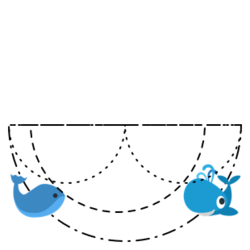Erk Erk Erk
 Below a depth of about 600 meters, sound travels at a speed that is dependent on the depth of the surface. Sounds actually travel faster the deeper one goes into the ocean, hence sound waves will travel faster by going downwards first.
Below a depth of about 600 meters, sound travels at a speed that is dependent on the depth of the surface. Sounds actually travel faster the deeper one goes into the ocean, hence sound waves will travel faster by going downwards first.
Suppose that two whales, some distance apart, play at the surface of the sea. One whale emits a cry, which travels toward the other whale along an arc that goes down 7.5 kilometers (without hitting the ocean’s bottom). How long (in seconds) does the cry take to reach the other whale?
Assume that the speed of sound at depth D km is kilometers per second (so the speed changes even at the surface, contrary to the initial statement).
This problem is shared by Gary Antonick .
This section requires Javascript.
You are seeing this because something didn't load right. We suggest you, (a) try
refreshing the page, (b) enabling javascript if it is disabled on your browser and,
finally, (c)
loading the
non-javascript version of this page
. We're sorry about the hassle.
This problem deals with finding a geodesic in a non-Euclidean geometry (since the speed varies at different depths). For those who are familiar with the theory, by comparision with the Poincare half plane, you will realize that the geodesics correspond to circles that are 72.5 kilometers above the surface of the ocean.
For a solution, you can refer to the New York Times NumberPlay Blog , that is run by Gary Antonick.